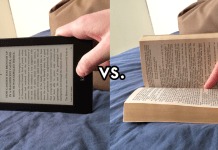 Tired of pathetic e-reading software from Amazon, especially if you’re past the novice stage? Maybe you should ask General Motors to buy out Jeff Bezo’s e-book side.
Tired of pathetic e-reading software from Amazon, especially if you’re past the novice stage? Maybe you should ask General Motors to buy out Jeff Bezo’s e-book side.
Let me explain. GM has a market cap of $47 billion. Amazon’s is $287B. Nevertheless, here’s a modest proposal for GM at least to try to gobble up the e-book side and apply the same level of innovation it has in coming up with improved electric cars and gas-electric hybrids.
Read Ars Technica and click on the accompanying video; and also see earlier coverage there and on CNET, as well as GM videos (scroll down). Fully charged, the Chevrolet Bolt EV can go 200 miles, a major boost made at the urging of customers. Get near the EV and, GM says, your smartphone can connect automatically. Cost is $30,000 after government incentives, well below Tesla’s (granted, the EV isn’t in the same luxury class).
Mind you, innovation is not 100 percent AWOL at Amazon. TeleRead has been at the head of the fanboy pack in praising the $50 Amazon tablet’s potential for e-reading, at least with third-party software able to display a wide variety of fonts. I’ve been the biggest booster of them all. Low pricing is innovation. I’ve even won over the previously skeptical Joanna Cabot.
Still, despite the quality of the hardware in most cases, Amazon year after year keeps on offering variant of the same dumbed-down software for e-reading. An advanced mode, providing for such extras as all-text bolding capability, would be a cinch for Amazon to add. Meanwhile just look at what Moon+ Reader Pro can do compared to Kindle e-reading software. Moon’s resources are a speck of Amazon’s.
Now compare Amazon’s laziness here with GM’s diligence in coming up with better versions of its electric vehicles and hybrids. From Ars: “The first-generation Volt taught Chevrolet quite a lot about electric vehicles, and its enthusiastic fan base provided the company with a lot of feedback that has been incorporated into the new car. The interior is much-improved, as is the powertrain, which is both lighter and more powerful than before. The car combines an electric motor and 18.4 kWh battery with a 1.5L direct-injection gasoline engine that exists mainly to charge the batteries but which also sends power to the front wheels when it makes sense to do so.”
 Watching the CNET video, you’ll see the level of customization that GM allows in its dashboard display. Why doesn’t Amazon care as much about letting users optimize their Fire and Kindle views? Sure, you can talk about blue light filtering and speed reading and other wrinkles Amazon now includes, but it has been embarrassingly smug about basics such as fonts choices.
Watching the CNET video, you’ll see the level of customization that GM allows in its dashboard display. Why doesn’t Amazon care as much about letting users optimize their Fire and Kindle views? Sure, you can talk about blue light filtering and speed reading and other wrinkles Amazon now includes, but it has been embarrassingly smug about basics such as fonts choices.
Traditionally we think of high tech companies as energetic, bold and disruptive, and Amazon has laudably been that way in areas such as drones. When it comes to e-reading software, however, Amazon is snoozing away.
Don’t say, “Well, zillions of people are Amazon e-book customers, so how bad can the software be?” Point is, they’re customers because Amazon’s prices are reasonable and the inventory is vast, far ahead of the fifth-rate competition from Barnes & Noble (whose e-reading apps, by the way, are even worse than Amazon’s).
More importantly, they aren’t bothering to articulate their needs for better software options for advanced users. They just quietly end up relying on Amazon products less than they could. Meanwhile the e-book business isn’t growing as rapidly as before. And more attention paid to e-reading software could help give it a shot in the arm, especially if Amazon remembered that today’s novices will be tomorrow’s advanced users. By KISSing away, Amazon limits the market for its wares.
One reason for Jeff Bezos and the rest of Amazon to care more about e-reading apps: Kindle software could be embedded in cars (perhaps even happening now or about to happen). For safety reasons, no, I’m not worrying about fonts for the driver when the automobile is in motion; TeleRead readers already know how I feel about distracted driving. But how about the best possible interface for stationary use and audiobooks?
Note: Zero GM connections here, financially (although I certainly wouldn’t mind advertising from GM in the future). In fact, the company for years was near the top of my S list after it risked my life with its crappy Citation that stalled at intersections. For all I know, GM still has issues. But here, at least, it is doing what Amazon should be doing with its e-reading software. Innovating in the most meaningful of ways.
Note #2: In one version of this post, Joe Wikert’s byline accidentally went on. Joe is innocent! All opinions here are mine. Joe had nothing to do with this essay. I have no idea of where he would stand on the issues discussed—although I’m confident he would favor a KISS default mode for the Kindle and related apps. So would I. We’re talking, rather, about options tucked away in a menu for veteran users.





























I think you’re confusing what you want with what Amazon should do. Given my druthers I’d like to have more advanced features on my Kindle as well, but I think what Amazon is doing is probably pretty smart.
Remember, reading is a simple thing to do. We just look at the words till we finish the page and then we turn the page and do it again. Anything else is extraneous and possibly a distraction. My Kindle already has a lot more features than I use.
I have a few Kindles, actually, and a few Kobos. The Kobos do have all the features you ask for in the Kindle but I still use the Kindle most of the time. It’s just a more pleasant and easier to use device and it’s presentation of text is more satisfying to me.
The Kobo lets me adjust the font in ways I can’t on the Kindle, although for those who want to there really are ways to do some of it on the Kindle. Changing the available font sizes, for example, is an advanced technique that’s very easy to implement. It’s just a matter of copying a file to the Kindle and rebooting. How many people bother? I tried it and thought it was very nice but I kept using the same old font size so I eventually removed it.
As for Amazon not innovating, it’s easy to forget their history. They made the first Kindle, a clumsy device whose design might best be described as some kind of joke. But it worked and it did things no other ereader before it did and it started an industry. And then it got better, evolving eventually to the Voyage and the latest Paperwhite. That’s a pretty huge chunk of innovation. I think they’ve pretty well perfected these things and the only thing left to do is incremental change, and they’re working pretty hard at that.
I would love to see an Advanced Features button that, when pressed, will give me the kind of options I have on the Kobo, or better yet, Moon+, also my favorite reading app. I’d be overjoyed. But I don’t think that would be a smart move for Amazon. It would greatly increase their support costs and I’m pretty sure that’s why they don’t do it. They do offer great support and I suspect their support costs are probably a lot higher than other companies so this has to be a major concern for them.
I don’t think the problem is Amazon’s laziness at all. If anything it’s because of the bad luck that Amazon, a major book seller, became the developer who popularized ereaders. We’d have been much better off if Samsung or Motorola thought this technology up and made sure it would work with ebooks from Amazon and B&N and Borders and others. Then other hardware manufacturers would be competing with a better device and they’d all be trying to outdo each other and ereaders would be way more expensive than they are now but they’d have to make them do everything we wanted or else. Then we’d have ereader competition.
Now what we have is ebook seller competition. Not nearly enough of it but it’s all the competition we have. And since the ebook sellers are making the devices to read their books they make them in such a way as to maximize their profit. They can compete with better service and that works so they don’t have to compete with devices. Devices have to be excellent but they don’t have to be what we want.
The problem is the system in which book sellers make the ereading devices. It’s a bad system but it works and I’ll be surprised if it’s going to change. Amazon doesn’t have any motivation to change it. Changing it would hurt Amazon.
Lately I’ve been using Moon+ on my phone to read. It’s a kind of experiment. I’m limited to about 15 or 20 minutes per session but if I stop a few minutes I can read another 15 or 20 minutes. I’ve been doing this now for more than two weeks and so far it’s working well. I’ve always had Moon+ in my pocket on a phone with my current book so I could read wherever I am but I did most of my reading on the Kindle. Now I’m trying to just use Moon+ and it’s working nicely. It means changing my reading habits a bit but so far I’m not finding that burdensome. I won’t really decide if I’m going to stay with this until I’ve done it a bit more and then try reading for a while on my Kindle again to compare. But this isn’t bad. I already know I could keep doing this if I decide to.
Barry
@Barry: Thanks for your thoughtful comments, some of the most skillfully presented that I’ve seen from you. But I’ll still respectfully disagree.
You yourself admit you’d “love to see an Advanced Features button that, when pressed, will give me the kind of options I have on the Kobo, or better yet, Moon+, also my favorite reading app.” You’re just worried about support costs. I have a very capitalistic solution. Treat this like “special offers,” aka ads, which people pay to turn off. Do the reverse. If Amazon is worried about support costs, let people pay to turn the advanced features on. In the interest of sustainability, I very much want the Kindles and Fires to be profitable for Amazon. I think I’ve arrived at a good compromise. What do you think?
As for your analysis of how we got into this mess, I absolutely agree with you. Life would have been so much easier for us readers if booksellers didn’t control the major platforms. One solution is to keep pressing for ePub (yes, you’re welcome to disagree) as well as the end of DRM for retail purposes. It is an evil, loathsome technology that hurts everyone in the end by making books less of a permanent medium. Amazon’s real advantages are breadth of inventory and in many cases low prices. ePub and the end of DRM (with social DRM perhaps as a replacement?) won’t change that.
Meanwhile I’m so happy you enjoy Moon+ and may stick with it. And that’s even without having the text/background contrast issue that I do (the one making me beg for the option of all text bold).
Thanks,
David
I agree with you that the big bugaboo in all this is DRM. I suspect Amazon wishes it would go away as much as you and I do. That’s probably one of the major contributors to their support costs. But, still just guessing, if they removed DRM (meaning encryption, since I don’t believe watermarking is really DRM except nominally) very likely they’d lose most of their publishers and their titles.
In the early days of Audible they set up a forum with a few invited customers and various officers in Audible and some of their development people and the presidents and VP’s of several Audible branches in various countries. In it we discussed all sorts of issues to give customer feedback they could use for planning purposes, and, of course, DRM was one of them, usually brought up by customers. It was one of the few areas about which pretty much everyone agreed. The people at Audible hated DRM more than the customers did. But they felt they were stuck with it if they wanted to offer a reasonable number of titles. By the way, this was before Amazon bought Audible so I really don’t know that this applies to Amazon, but I’ll be surprised if it doesn’t.
Imagine a world in which there was no encryption on our books, which would allow anyone to make a device to read them. As soon as that happens format ceases to matter. Sure, mobi might involve some royalties but it’s already used by a lot of places so that obviously doesn’t prevent sellers from using it. The only reason a competitor’s device can’t read Kindle books directly is because of DRM. Without that what’s standing in the way of real competition?
I wish it would happen. Actually I suspect it will happen eventually, or at least I hope it will. It did with music. Everyone would gain. But that’s probably way down the road. There are major wars going on in publishing right now but this really isn’t one of them. It’s just us tech lovers who are grumbling.
Another thing that could happen to accomplish the same purpose would be a reasonably priced e-ink phone. I’d have given up my Kindle years ago if I could have one. The very few available are expensive, hard to get, unlighted, unsupported and, from reviews, not that good.
My guess is that this isn’t going to change; that this is the situation we’ll have to live with for a while. If I’m going to fight a battle I think I’ll pick one where I have a better chance, perhaps against a thunderstorm. 🙂
Barry
@Barry: Another good one from you, thanks. You write, “It’s just us tech lovers who are grumbling.” Actually, if they can understand what is happening, lit lovers will feel the same. DRM, at least the encryption-reliant kind, makes books less of a permanent medium. The good news is that even publishers, as shown by events in Germany, are opening themselves to the possibilities of watermarking. As for E Ink phones, give ’em time. They’ll almost surely be better and cheaper. Meanwhile, to refer to the earlier comments, what do you think of options for advanced Kindle users–paid for with a system similar to the one through which people can turn off the ads? David
I’d be more than happy to pay extra for advanced features. But which advanced features? I’m happy with the fonts as they are. I’m happy with pretty much everything on my Voyage as it is. What I’d like to see is scrolling. I’m really not sure that’s practical on e-ink but if it is it’s what I’d pay extra for.
Actually some of the features have been “improved” and I’d pay extra to have the improvements rolled back. Kindle used to have a great bookmark system. The new one requires thought and I can’t use it casually. It’s far more powerful but I much prefer the simplicity it used to have.
For a long time my favorite Kindle feature was X-Ray. I used it like a character list. Now it’s gotten too complicated for that and I’ve quit using it and use text search to remind myself who characters are. I’d love to have both of those features back the way they were and I’d pay a good price for that
@BarryEm: Well, no mystery in case of the need for all-bolding capability or, better, the ability to vary font weight. Please, please, Amazon—you can give us if Kobo can! Why don’t you care about this accessibility issue! Scrolling would be nice. Maybe better display tech or a faster chipset would help in the future if we can’t have scrolling now. Agree with you re X-Ray. So there you have a few examples if what customization could offer. And, again, yes, I haven’t any problem with Amazon charging a reasonable fee to pay for the support. David